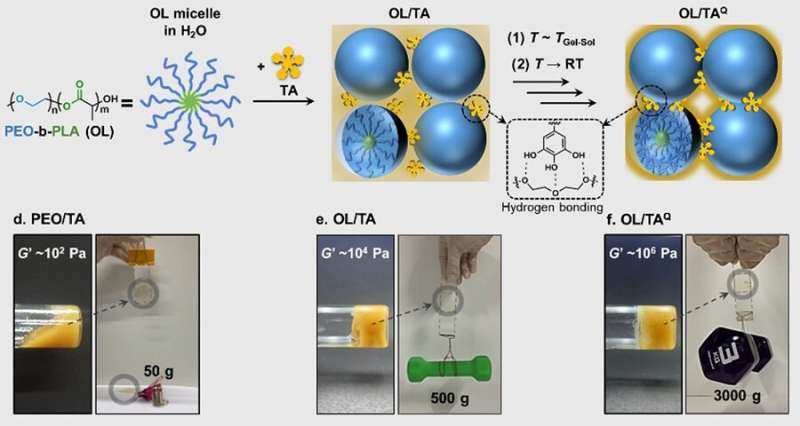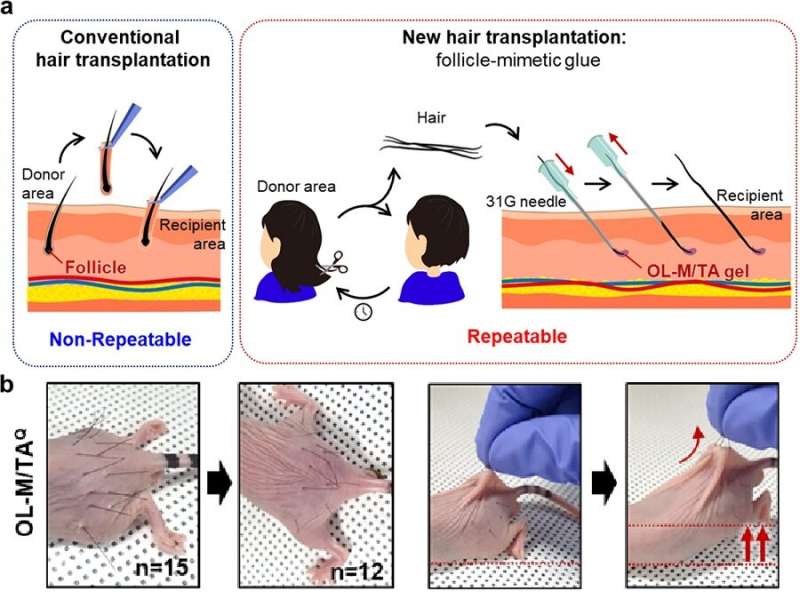Team develops biocompatible adhesive applicable to hair transplants

Medical adhesives are materials that can be applied to various uses such as wound healing, hemostasis, vascular anastomosis, and tissue engineering, and they are expected to contribute greatly to the development of minimally invasive surgery and organ transplants. However, adhesives that have high adhesion and low toxicity while also being capable of decomposing in the body are rare.
Adhesives based on natural proteins, such as fibrin and collagen, have high biocompatibility but insufficient adhesive strength. Synthetic polymer adhesives based on urethane or acrylic have greater adhesion but do not decompose well and may cause an inflammatory reaction in the body.
A joint research team led by Professor Myungeun Seo and Professor Haeshin Lee from the KAIST Department of Chemistry has now developed a bio-friendly adhesive from biocompatible polymers using tannic acid, the source of astringency in wine.
The research team focused on tannic acid, a natural polyphenolic product. Tannic acid is a polyphenol present in large amounts in fruit peels, nuts, and cacao. It has a high affinity and coating ability on other substances, and we sense the astringent taste in wine when tannic acid sticks to the surface of our tongue. When tannic acid is mixed with hydrophilic polymers, they form coacervates, or small droplets of jelly-like fluids that sink.
If the polymers used are biocompatible, the mixture can be applied as a medical adhesive with low toxicity. However, coacervates are fundamentally fluid-like and cannot withstand large forces, which limits their adhesive capabilities. Thus, while research to utilize it as an adhesive has been actively discussed, a biodegradable material exhibiting strong adhesion due to its high shear strength has not yet been developed.

The research team figured out a way to enhance adhesion by mixing two biocompatible FDA-approved polymers, polyethylene glycol (PEG) and polylactic acid (PLA). While PEG (which is used widely in eyedrops and cream) is hydrophilic, PLA (a well-known bioplastic derived from lactic acid) is insoluble in water.
The team combined the two into a block copolymer, which formed hydrophilic PLA aggregates in water with PEG blocks surrounding them. A coacervate created by mixing the micelles and tannic acid behaved like a solid due to the hard PLA components, and showed an elastic modulus improved by a thousand times compared to PEG, enabling it to withstand much greater force as an adhesive.
Furthermore, the research team observed that the material’s mechanical properties can be improved by over a hundred times through a heating and cooling process that is used to heat-treat metals. They also discovered that this is due to the enforced interactions between micelle and tannic acid arrays.
The research team used the fact that the material shows minimal irritation to the skin and decomposes well in the body to demonstrate its possible application as an adhesive for hair transplantation through an animal experiment. Professor Haeshin Lee, who has pioneered various application fields including medical adhesives, hemostatic agents, and browning shampoo, focused on the adhesive capacities and low toxicity of polyphenols like tannic acid, and now looks forward to it improving the limitations of current hair transplant methods, which still involve follicle transfer and are difficult to be repeated
The research was published online on August 22 in the journal JACS Au under the title “Biodegradable Block Copolymer-Tannic Acid Glue.”
Acid may be key ingredient for better adhesive strength, electronic components
Jongmin Park et al, Biodegradable Block Copolymer–Tannic Acid Glue, JACS Au (2022). DOI: 10.1021/jacsau.2c00241
Citation:
Team develops biocompatible adhesive applicable to hair transplants (2022, October 10)
retrieved 10 October 2022
from https://phys.org/news/2022-10-team-biocompatible-adhesive-applicable-hair.html
This document is subject to copyright. Apart from any fair dealing for the purpose of private study or research, no
part may be reproduced without the written permission. The content is provided for information purposes only.
For all the latest Science News Click Here
For the latest news and updates, follow us on Google News.

